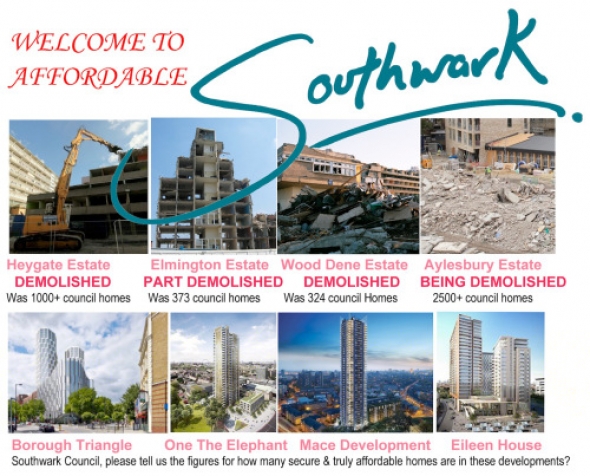Regeneration Is Violence
Southwark Notes on the early bloom of London housing struggles in 2015. Reposted from: https://southwarknotes.wordpress.com/2015/02/21/regeneration-is-violence/
How is it in London in 2015 that people who reside in public housing can be subject to such extremes of subtle and unsubtle violence? When we use the word violence what do we mean? Well for starters we mean the slow burning, long-term violence done to those who are being forced out of their homes in the name of ‘regeneration’ with it’s routine accompanying upheavals, anxieties, stresses and affects on physical and mental ill health.

How is it to lose you home? What does it mean to be ‘regenerated’ and be asked to leave your home where there is no alternative presented to you but to lose your home. What does ‘home’ mean to people in this instance – isn’t it a vast collection of memories, events, experiences and also connections to others around you? How do you ‘regenerate’ those very personal aspects of people’s home lives and their community?
What is it like to be live day-in and day-out, not wanting to leave your home as more and more people around you are leaving? What is it like to have to move to Sidcup in Kent as you can’t afford to stay local as gentrification means your leaseholder compensation from the Council is too small to buy you anything where you have lived for much of your life?
What does it feel like to be treated with zero dignity or respect even though your crime is only to live in a home where the Council and it’s partners want the land your home sits on? Do you and your life and your community’s life count in this instance? Or are you just a statistic on the regeneration paperwork? How is it to be issued a Compulsory Purchase Order for your home that you have paid off, receive a low valuation and then be forced to take up a new mortgage for a home miles from where you want to live?

How is it that opponents of moving from their homes, of social cleansing, of gentrification, can be ignored by the Council as if these desires, feelings, views and good common sense simply does not exist. How is it to be in your latter years, be removed from your community and support networks? We know from our interviews with ex-Heygate tenants that there is a lot of anxiety, sadness, depression, ill health and in some cases early deaths happening with many of those decanted and displaced from that community.

How is that a Council would rather smash up it’s decanted homes than let homeless people live in them?
How is that once you could live in London in cheap housing because that was a common sense housing policy but now the policy is to force you out in favour of developers profits, those who use housing as investments, those who already have too much and those who think you are unworthy to live in central London?
This is what we mean by violence. This is where we see that regeneration is a type of violence.
These social costs of demolition and displacement are huge and yet the Council ignores this in favour of simple economic arguments that pretend ‘regeneration’ is all about benefiting a local community. But Londoners and especially those subject to these awful schemes are winning the argument that such schemes are only really about social cleansing. It seems that the last 6 months of high-visibility campaigns have won that battle. The next stage has been reached and campaigns are no longer simply arguing that regeneration is gentrification but are now moving into practical and shared actions to defend their homes from regeneration and to act against evictions – Focus E15 mums campaign and their re-occupation of Carpenter’s Estate in Stratford, the New Era estate in Hoxton victory of preventing a new private owner of their homes from evicting them, the Guinness Trust occupation in Brixton and the Aylesbury Occupation, are all amazing moments of the last few months.
And then there is a less subtle violence that all concerted actions against this regeneration bollocks will have to face and that is the ultimate use of the police and bailiffs by Council’s to get their way. This week we have seen that violence on Aylesbury Estate:
Aylesbury Occupied
This last fortnight has seen a somewhat incredible local and public denial that regeneration of Southwark’s large council estates is good for local communities. You probably already saw that part of Chartridge block on Aylesbury estate had been re-occupied by protestors who wanted to both draw attention to the social cleansing of poorer parts of Southwark and to give a boost to local housing campaigners on and off the estate. It certainly did that with daily meetings, petitions by residents of residents on the Aylesbury, street stalls on Walworth Rd, public meetings and a lively posting of news and arguments up on the Internet. All of these events and activities were organised by the occupiers, local residents and local groups.
Council’s First Response
Southwark Council’s only response was to repeatedly use the same tired old press statement in any media coverage. None of the detailed arguments made by Aylesbury residents, leaseholders, the occupiers and people like us were answered in any way. Mark Williams, Cabinet member for Regeneration, instead claimed in the oft repeated statement that ‘In Southwark we are tackling the housing crisis head on and in the last three years we have built more affordable homes than any other London borough. The squatters do not represent the residents of the Aylesbury and are risking the delivery of the very homes they claim to be campaigning for, for the people they claim to be campaigning for. Southwark is working hard to tackle the London-wide housing crisis but others must also play their part to provide the homes Londoners need.’
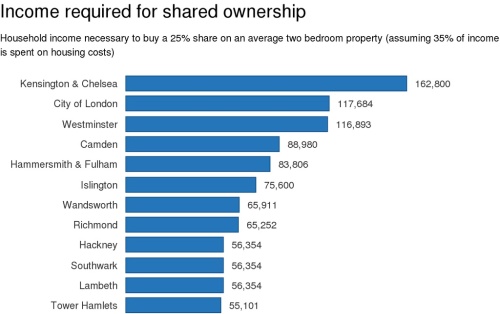
We would say simply: How do Southwark think they are tackling ‘the housing crisis’ by building these so-called affordable homes (eg. 25% shared ownership in Southwark requires an income of £56k for a 2-bed)? 47% of households in Southwark have incomes of £15,000 or less per annum. The median income for Council tenants was just £9,100 (Southwark key housing data 2012/13). So the numbers just don’t add up as numerous criticisms can be found of ‘affordable’ homes where it’s clear that are not ‘affordable’ unless you are on a very good wage or unless you can move from a cheap council rent to a more expensive Housing Association rent. So decanting tenants out of the Aylesbury, demolishing it, and having Notting Hill Housing Trust build some social rented homes but mostly private or shared ownership homes is not tackling the housing crisis for local people. Decanting tenants off of the Heygate Estate, demolishing it, and having Lend Lease build a tiny amount of social rented homes (79) but mostly private or shared ownership homes (3000) is not tackling the housing crisis.
Both regeneration schemes immediately reduce the numbers of available council homes by demolishing them and not replacing them (Heygate 1100 homes gone, Aylesbury will be 3000+ gone). Not only are council places lost but decanted tenants are re-housed mostly in existing council housing stock further reducing available council homes for those 18,000 people on the waiting lists. The experience of Heygate is that when some new homes were built for decanted tenants locally very few ex-Heygate residents took up the offer as they were either too expensive or they didn’t want to move once more. By the time these homes were built the Heygate community had already been displaced so people felt there was no longer any point in returning to near the Heygate site. It will be the same for the Aylesbury regeneration scheme. In both cases, tenants and residents have long argued that they want to stay in their local area and in their local community. If you have kids, are ill, are elderly, are low waged or unemployed, like large spacious and light flats, like Walworth and its shops and so on, these are some of the many reasons people do not want to move. Council rent means being able to have a decent home and to be able to survive for many many people.
Removal of council homes means upping the level of those just above, on or below the poverty threshold and Heygate and Aylesbury sites are high on the Index of Multiple Deprivation. Let’s be clear, regeneration schemes do not tackle poverty, they make it worse. Decisions made in offices or at fancy dinners with developers do not arise from actual contact with local people. As was said this week on Twitter re: Aylesbury regeneration – Southwark Council just ‘doesn’t understand Council Housing from the perspective of a tenant’. We think that’s a very useful point. They do not understand and really do not care about the impact of these schemes on local communities. That’s the impact on the very people who vote them in to supposedly look after their community.
Never Mind The Ballots
The Council’s lack of will to actually enter into argument and debate about it’s regeneration policies comes from the arrogance of those who now control the Council. It’s a very top-down affair of thinking they know what is good for us without ever asking us directly and with a transparency and accountability that is needed. Instead, they use consultation companies to arrange ‘show and tell’ meetings with those facing regeneration where the outcome of those meetings have already been pre-determined to show pro-regeneration support. We have already written much on the consultation con and we won’t repeat here. However, two illustrations might shine a light on the current state of whether the Aylesbury regeneration is supported by a majority of residents :
When the draft Aylesbury Area Action Plan (AAAP) was published in 2009, a series of ‘consultation’ meetings and events happened. The AAAP was the master-planning document was the blueprint for how the demolition and regeneration of the estate would be. On 6th and 7th March 2009 the Action Plan was ‘publicly displayed’ in Thurlow Lodge Community Hall and people invite to comment on it. Over the weekend, ‘133 people recorded their attendence over the two days…of whom 100 filled in questionnaires’. The Council was then able to write that this event ‘clearly showed local support for the Action Plan where 82% of questionnaire respondents supported the vision for the Aylesbury’.
The Aylesbury had approx 6000 or 7000 residents. If we do some maths, we can argue that responses from 100 people out of whom only 82 were supporting the regeneration is not a large very sample to trumpet out local resident support for the scheme. This is especially the case when in 2001 73% of residents voted against their homes being demolished and their tenancies being transferred to a Housing Association. Yet the Council now ignores the ballot and also constantly refers to a ‘vast majority of residents who want to be rehoused’. It also refuses to runs ballots on any further estate that they seek to regenerate as they know people have rumbled the regeneration rip-off.
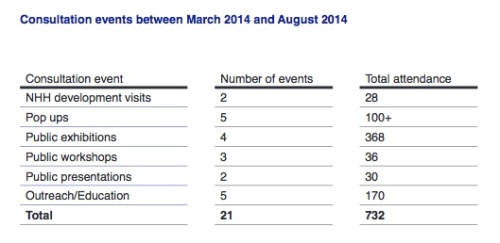
The 2014 Statement of Community Involvement summarises the process of public consultation that has taken place on the regeneration of the Aylesbury Estate in preparation for the submission of a detailed and outline planning applications. In the above chart you can see how many actual people attended each consultation or event. At the end of the chart the total attendance is put at 732 people in attendance. But how is it possible to know whether these 732 attendees were all different people and not a more likely mixture of the same people? How is it possible to know what they even said? The report only mentions in passing peoples obvious concerns about displacement. (You can see the hole-ridden 148-page Statement of Community Involvement here).
However, what struck us this week as we went to the occupation, the well-attended public meetings, the petition work or when we just met people passing through the estate was how few of them actually believed regeneration was in their interest. In fact the term ‘social cleansing’ came more out of people’s mouths than ours in these days. People instinctively grasp that what Southwark is doing is moving on poor people on large estates and moving in under the phony guise of ‘mixing the community’ more wealthy people. In one small shop on Westmoreland Rd, the owner was worried how his business would fare when the Aylesbury residents all moved on and more affluent people moved in. There was also a common acceptance of people living in empty buildings if they want too. People said again and again – ‘if they are empty why shouldn’t people live in them’.
Yet none of these concerns and desires not to leave the estate or the area, nor people’s support for the Aylesbury occupation seem to register in the Council’s propaganda machine. This week saw Leader of The Council, Peter John expressed dismay that any of this regeneration stuff could be seen as ‘controversial’. In light of Heygate scandal, the Aylesbury social cleansing with it’s stressful and pressured removal of tenants, the Compulsory Purchase Orders of very elderly residents, the non-affordable new housing, you wonder what there is there that isn’t controversial! Re-iterated again and again through public events about regenerating the Aylesbury is that local residents see ‘affordability’ of new homes as their major issue and concern and yet the new homes are, as we know, going to be very unaffordable.
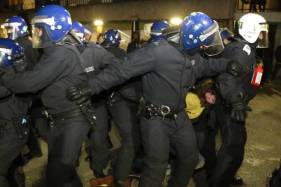

Council’s Second Response: More Violence
Every day, the Occupation held a public meeting at 6.30pm where many people came and discussed both the regeneration and the Occupation and how to proceed. Within the Occupation there was clearly a sussed understanding of how they were occupying to help local people re-energise their opposition to the regeneration.
The Council’s line was that ‘the squatters’ had no support nor we’re they representative of local people’s feelings. They tried to distance any support for the occupation that as we have said was clear by just pretending that a part of the estate has been squatted and this had nothing to do with the regeneration or it’s opponents. At one point, Peter John called the squatters ‘fakes’ because some other squatters who were clearly nothing to do with the occupied Chartridge block held an unwanted noisy party. Police both accepted that this was nothing to do with the protest occupation but also did nothing when some of the occupiers were attacked by the party squatters when they asked them to stop the music which was pissing off local people.
On Tuesday evening, the Council decided it needed a final reckoning, and after securing an Interim Possession Order in court that morning, police arrived on the scene team handed. Although they had been filming the occupation that day, had been stopping and searching people there, had police on site 24 hours a day and had been trying to understand the situation with the occupation, they still basically spent a couple of hours evicting an empty block. The Occupation has simply moved at the start of the police raid into the adjoining block that was not covered by the Possession Order. The defence of this block was made even easier because when the Council had previously smashed up these flats a week before to prevent them being occupied they had also erected sturdy metal fences that now aided the occupiers against further police incursion.
At this moment of impasse, the police then made 6 violent arrests of supporters from the crowd of 100+. It was entirely provocative when the evening had so far been angry but calm even when the police were raiding the empty block with a show of force.
With no eviction then in place, outsmarted and somewhat deflated, the Council then tried to persuade the police that they had evidence of criminal damage committed when the occupiers took over the block. Police then came to the occupied block saying they were going to arrest all who didn’t leave due to ‘criminal damage’. The occupiers and crowd made a great job of arguing that this was a lie and somewhat ironic as the Council had already smashed up the block the week before. In the end, the Chief Inspector on the night with a nervousness that was quite funny to watch declared a dispersal order to clear the area but also didn’t go through with an illegal eviction.
The Council, until it makes it’s next legal move, has been hiring private security to be a pain in the ass to the occupation, producing more intimidation and violence and its supporters and is also building many fences around the block as if laying it to siege. Potentially very dangerous but then the Council always operates from siege mentality unable to actually talk to local people, treat them nicely, see the actual harm of their regeneration regime and so on. They remain hunkered down in their in posh houses or secure in council chambers.

As we write the occupation continues at 69-76 Chartridge Block, Westmoreland Rd, SE17. Their website is here for news and updates. Last Saturday they held a Family Fun Day for all and this brought more people to the place to see what’s going on and to enable further discussions around local people’s objections to this ‘regeneration’.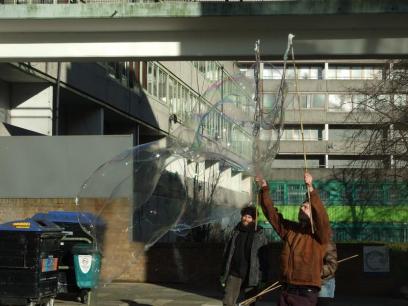

We wonder when Peter John or any high-ranking regeneration officers last visited the Aylesbury for a chat with locals? Any guesses?
Mute Books Orders
For Mute Books distribution contact Anagram Books
contact@anagrambooks.com
For online purchases visit anagrambooks.com

